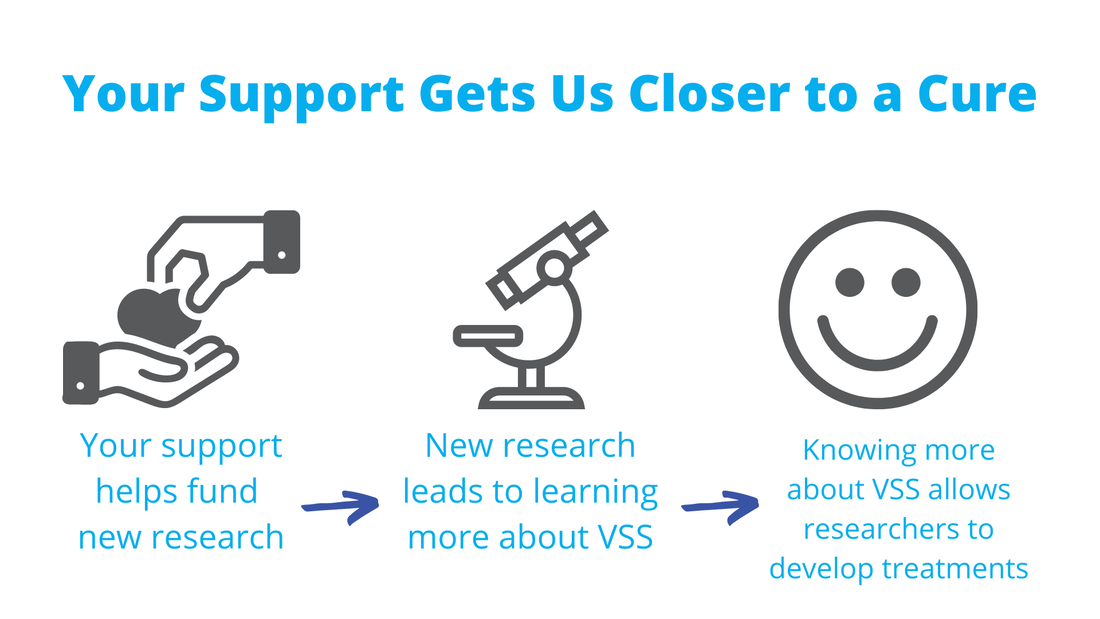Accelerating a cure for Visual Snow Syndrome (original) (raw)
WHAT IS VISUAL SNOW SYNDROME?
Visual Snow Syndrome (VSS), is a chronic, debilitating, and persistent neurological condition which affects a person’s vision, hearing, and brain function. The primary, and shared, symptom of VSS sufferers is Visual Snow. This resembles “TV static” and is perceived and seen as millions of moving and flashing dots over the entire visual field. This static is seen whether the eyes or opened or if they are closed. While Visual Snow itself is not as rare as once believe, Visual Snow Syndrome is. The full-blown syndrome carries multiple symptoms with it, in addition to the symptom of Visual Snow.
WHAT ARE THE SYMPTOMS OF VISUAL SNOW SYNDROME?
While the primary symptom of Visual Snow Syndrome is Visual Snow (static vision), there are numerous other symptoms that accompany this condition. Many of these are seen in migraine sufferers, making diagnosing VSS difficult for medical professionals who do not have a full understanding of the condition. Many patients are misdiagnosed with Status migrainosus, or a similar diagnosis in the migraine family. Here is a listing of symptoms that a VSS patient may experience:
- Static across entire visual field
- Eye Floaters
- Trails
- After-images (positive and negative)
- Blue field entoptic phenomenon
- Impaired night vision
- Glare
- Ghosting
- Trouble tracking
- Tinnitus (ringing and buzzing in ears)
- Twitching
- Tremors
- Depersonalization
- Vertigo
- Dizziness
- Sensitivity to fluorescent lights
- Sensitivity to sunlight
- Migraine
- Brain Fog
- Swirling lights or clouds in vision with eyes closed
- Tingling
- Heaviness of Limbs
DIAGNOSIS AND TREATMENT
Currently there are no medical tests to diagnose Visual Snow Syndrome. This can be done by a doctor, usually a neurologist or a neuro-ophthalmologist, and is based on the patient’s symptoms. If a patient is only seeing static, with no other symptoms, then they would have a diagnosis of Visual Snow, as a symptom, but not Visual Snow Syndrome. If a patient has additional symptoms, like the ones listed above, along with their Visual Snow (static vision), then they would receive a diagnosis of Visual Snow Syndrome.
While awareness and research have multiplied over the past decade for Visual Snow Syndrome, this is still an incurable and untreatable condition. Doctors and patients can work together to try and alleviate some of the visual symptoms by the use of colored lenses or sunglasses. Patients may find white noise sound machines helpful to drown out the tinnitus. Sometimes treating an underlying condition, such as migraine, can help patients get some measure of relief from their Visual Snow Syndrome symptoms.

We are working towards raising awareness and accelerating a cure for Visual Snow Syndrome. We want to educate doctors worldwide, and support researchers, so treatments, and one day a cure can be found for Visual Snow Syndrome (VSS). Every study we fund and doctor we educated gets our VSS community closer to a cure in our lifetime.
2024 Fundraising Goal
The Eye on Vision Foundation’s primary focus in 2024 is funding ground-breaking research and raising awareness for Visual Snow Syndrome and its related symptoms. Our 2024 goal is to raise $120,000, which will be split amongst several researchers and research projects into VSS. Fundraising is essential in order to meet these goals. We need your help during these trying times to get there.
